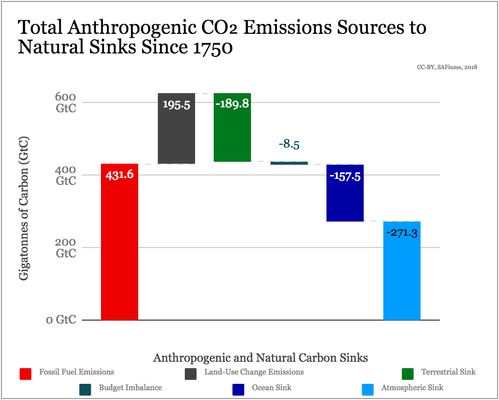...
Global Carbon Budget 2018 Infographics
...
Notable Coverage
Vox: IPCC Special Report, and links this year's UNFCCC meeting: COP24.
Climate Change Exposé, New York Times: Loosing Losing Earth: The Decade We Almost Stopped Climate Change
...
How much Carbon do we need to remove? A rough estimate of is 500 Gt Carbon from emissions. This number shoots up close to 700 Gt Carbon if the Land Sink deteriorates. As of 2017, the total was 627 Gt Carbon.
| Iframe | ||||||||||||
|---|---|---|---|---|---|---|---|---|---|---|---|---|
|
The red eXes are extrapolations of when we'd hit 450ppm from the light blue Mauna Loa ppm to GtC average curve. This assumes the current exponential growth rate continues unheeded till 450 ppm. 450ppm is projected to happen by 2032. The solid black line is the amount of fossil fuel emissions combined with land-use change emissions which are projected to be in the atmosphere to cause 450 ppm.
...
Note, to go a step beyond pure carbon - dioxide sequestration and fully remove carbon from the global carbon cycle, carbon can be solidified to stop it from expediting climate change.
...
If one models global temperature and atmospheric carbon dioxide concentration (CO2 PPM) over the last 5M years using the Antarctic Vostok Ice Core data correlated to ice sheet existence, a large region emerges which includes data points starting with Northern Hemispheric Glaciation at about 2.7M years to just prior to the present. This data correlates a range of atmospheric CO2 concentration from 180 CO2 PPM[4] to sub 370 CO2 PPM[5] to temperatures that stay within a change of 2.5 Cº, over the last 2.7 M years. Outside of 2.7M years, we observe higher temperatures and CO2 concentration and radically reduced Arctic ice sheet, glaciers, and radically raised ocean levels.[5] At present, Earth's climate is exceeding the previous stability zone due to increased global surface temperature and atmospheric CO2 concentration, leading to radical changes to global oceanic oscillations, and possible shutdown of thermohaline of the thermohaline circulation[6] and increased reduction in polar ice sheets and further sea-level rise. The shear fact that CO2 concentration has surpassed that during the Northern Hemispheric Glaciation point should raise great concern.
Additionally, historically the change in CO2 concentration happened at a slow rate on the order of 1 ppm per century, where as whereas humans have caused changes on the order of about 100 ppm per century. "And the system variables (carbon dioxide and temperature) are now "decoupled" in the sense that we are far from equilibrium (rate of change). How global temperature responds to a combination of GHG forcing and loss of albedo (surface melting in Greenland) is unknown.", per Assoc. Prof. Robert Cormia.
...

